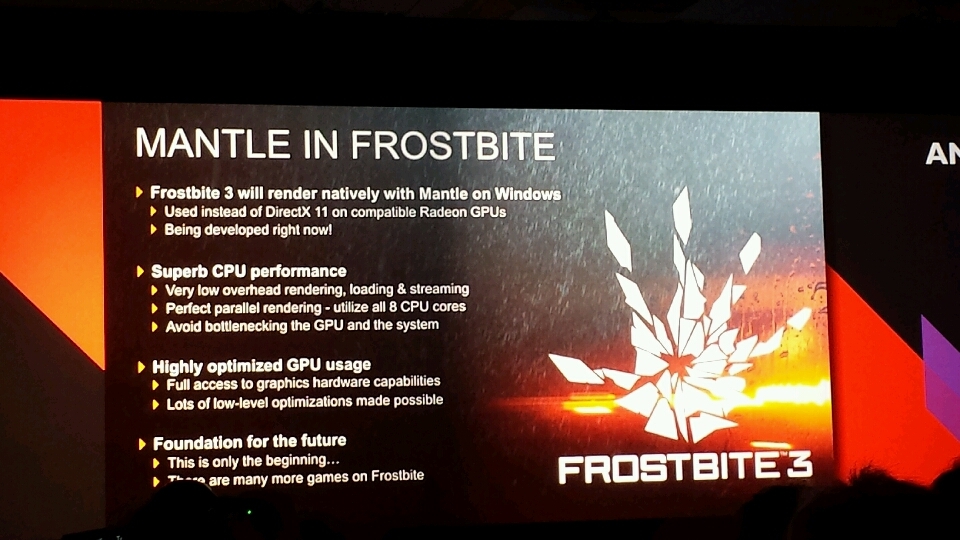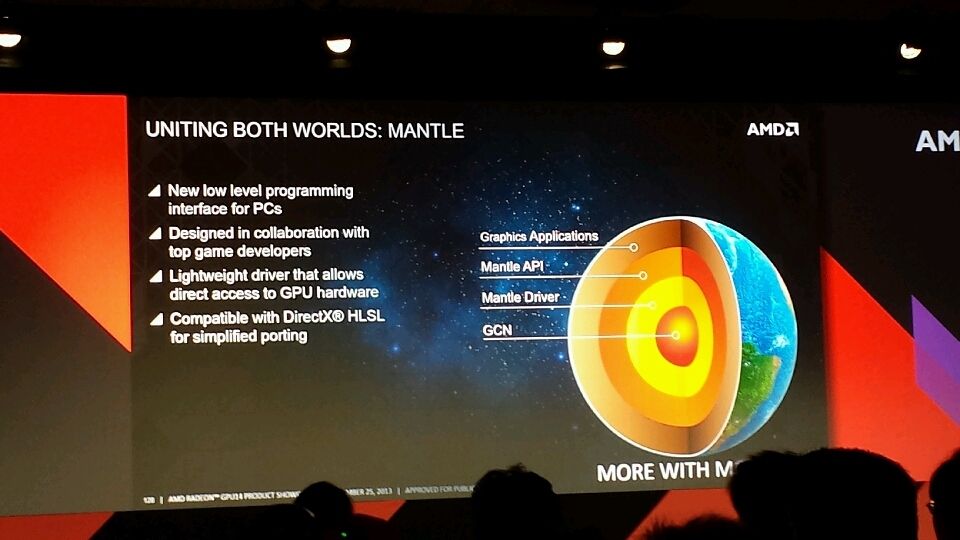AMD's Mantle API Gives Devs Direct Hardware Control
AMD has revealed an API that gives developers direct access to GPUs using the GCN architecture.
Now that AMD is powering all four major gaming platforms – namely the Wii U, Xbox One, PlayStation 4 and PC – the company has finally revealed its secret weapon to bind these platforms together: the low-level high-performance "Mantle" graphics API. This will allow developers to "speak the native language" of AMD's Graphics Core Next architecture used in modern AMD-based graphics cards and APUs.
"With Mantle, games like DICE’s 'Battlefield 4' will be empowered with the ability to speak the native language of the Graphics Core Next architecture, presenting a deeper level of hardware optimization no other graphics card manufacturer can match," the company said on Wednesday. "Mantle also assists game developers in bringing games to life on multiple platforms by leveraging the commonalities between GCN-powered PCs and consoles for a simple game development process."
The name is interesting in that AMD revealed its "Hawaii" Radeon R7 and R9 generation of GPUs at a press event in Hawaii, a beautiful island shaped by the active volcanoes along the Pacific Ring of Fire. The mantle is commonly known as the layer below the earth's crust, and is associated with volcanism. Based on a "global" diagram, the GCN architecture serves as the core, followed by the Mantle Driver, Mantle API, and the graphics applications serving as the "crust".
According to AMD, the Mantle benefits include reducing the CPU overhead to enable 9X more draw calls per second than other APIs. This will provide PC gamers proper multi-tasking scaling on the CPU without the need to handle all the background draw calls required by the older APIs. Other Mantle benefits include leveraging optimization work from next-generation game consoles to PCs, and new rendering techniques. Thus with direct access to all GPU features, developers can unlock higher graphics performance on consoles and gaming rigs with GCN-based GPUs.
The first company to support the Mantle API is Electronic Arts. The Frostbite 3 engine, developed by EA subsidiary DICE, will supposedly render natively with Mantle in Windows without the need for DirectX when running on GCN-based GPUs and APUs, but the engine will still be compatible with other rendering APIs. Johan Andersson from DICE indicated that AMD's API is similar to the one found on consoles where developers have direct access to the hardware for optimal performance. Mantle is also compatible with DirectX HLSL to simplify porting.
Support for Mantle will arrive in Battlefield 4 in December as a free and automatic update.
Will Mantle become another case of the Glide API? 3DFX created that API back in the mid-90s so that developers like id Software would have direct access to the Voodoo GPUs. Once additional GPUs became common on the market, OpenGL became the favorite until Microsoft beefed up the relationship between Windows and DirectX. Now smartphones and tablets have reignited OpenGL support, developers want to shun DirectX, and AMD is producing an exclusive API. However, this time around, this GPU spread isn't locked to mere gaming PCs.
Get Tom's Hardware's best news and in-depth reviews, straight to your inbox.
"AMD’s approach to providing a consistent gaming experience on the PC, in the living room or over the cloud — all powered by AMD Radeon graphics found in AMD graphics cards and accelerated processing units (APUs). The four pillars of the Unified Gaming Strategy — console, cloud, content and client — come together with the introduction of Mantle," the company said.
There's talk that Mantle is open-source, meaning Nvidia could add support to GeForce GPUs. But given the company's recent collaboration with Valve and Linux, Nvidia may be more inclined to focus on better supporting OpenGL (just a guess). Regardless, additional information regarding Mantle will be released at the AMD Developer Summit, APU13, taking place Nov. 11-13 in San Jose, California, and we will likely be there, but without the hula skirts.
Follow us @tomshardware, on Facebook and on Google+.

Kevin Parrish has over a decade of experience as a writer, editor, and product tester. His work focused on computer hardware, networking equipment, smartphones, tablets, gaming consoles, and other internet-connected devices. His work has appeared in Tom's Hardware, Tom's Guide, Maximum PC, Digital Trends, Android Authority, How-To Geek, Lifewire, and others.
-
CaptainTom This has massive potential. Looks like everyone is moving to drop DirectX. Can't wait to see the benchmarks of this vs DirectX.Reply -
iam2thecrowe AMD fan: "AMD dont do proprietry crap like physx, they stick to open standards, and thats why i like them"..........Reply -
ryude I would hope that we move towards OpenGL, proprietary doesn't help the consumers. Open source AMD!Reply -
anxiousinfusion Indeed. DirectX is going up against some strong competition this decade between OpenGL, Valve with Steam Machines and native Linux gaming, and now AMD's Mantle.Reply
#OperationPCGamerFreedom -
renz496 Can you guys clarify how open this new mantle API from amd? if the API indeed is open source will it be maintain by open community like OpenGL and OpenCL did? or is it much like tressfx which amd has total control in building and the future direction of the software but it can also be run on non amd hardware?Reply -
iam2thecrowe Replyrenz496
its for AMD's GCN, so its not open.
Can you guys clarify how open this new mantle API from amd? if the API indeed is open source will it be maintain by open community like OpenGL and OpenCL did? or is it much like tressfx which amd has total control in building and the future direction of the software but it can also be run on non amd hardware? -
Toolguns New tech news is good. Tech news for gamers showcasing increase for in-game performance...yeahhhh budddyyyReply -
s3anister Reply11603474 said:AMD fan: "AMD dont do proprietry crap like physx, they stick to open standards, and thats why i like them"..........
FTA: "There's talk that Mantle is open-source, meaning Nvidia could add support to GeForce GPUs."
You obviously didn't read the article, did you? Either way, this is a great step forward for AMD and for gaming.

